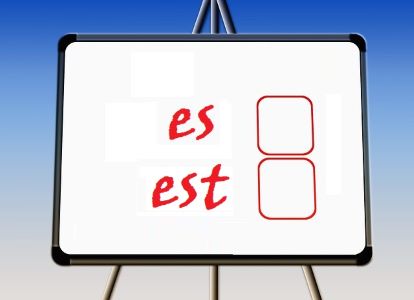When learning French, it is essential to understand the subtle differences between similar words to ensure clear and accurate communication. Two such words are “es” and “est,” which are both forms of the verb “être” (to be). However, we use the two forms in different contexts. A common point of confusion for learners is that “es” and “est” are pronounced the same in French, that is, [ɛ] in the International Phonetic Alphabet (IPA), which sounds like the English short “e” in “bed.” This article will explore the distinctions between “es” and “est,” providing examples and tips to help you use them correctly, including the nuances of liaison.
“Es” in French
“Es” is the second-person singular form of the verb “être” in the present tense. The verb “être” is conjugated in the present tense as follows:
| être (to be) | |
| je/j’ | suis |
| tu | es |
| il/elle/on | est |
| nous | sommes |
| vous | êtes |
| ils/elles | sont |
We use “es” when referring to “tu,” which means “you” (informal). We use this form when speaking directly to one person whom you are familiar with, such as a friend, family member, or peer. For example:
| Tu es mon ami. | You are my friend. |
| Es-tu prêt? | Are you ready? |
| Tu es très intelligent. | You are very intelligent. |
Remember that “es” is specifically tied to “tu.” Do not use it with other subjects.
“Est” in French
“Est” is the third-person singular form of the verb “être” in the present tense. We use it referring to “il,” “elle,” or “on,” which mean “he,” “she,” and “one/we” respectively. We use this form when speaking about someone else or in more general statements. For example:
| Il est professeur. | He is a teacher. |
| Elle est belle. | She is beautiful. |
| On est prêts à partir. | We are ready to leave. |
Use “est” with third-person singular subjects like “il,” “elle,” and “on.”
Liaison Cases for ‘Es’ and ‘Est’ in French
Liaison in French is the pronunciation of a normally silent consonant at the end of a word, when the next word begins with a vowel sound. Both “es” and “est” can form liaisons, but they follow specific rules:
Liaison with “Es”
When “es” is followed by a word starting with a vowel or mute ‘h,’ the ‘s‘ is pronounced like a ‘z’ to link the words smoothly. For example:
Examples:
| French | English |
| Tu es un ami. | You are a friend. |
| Es-tu en forme? | Are you in shape? |
| Tu es ici. | You are here. |
Liaison with “Est”
Similarly, when “est” is followed by a word beginning with a vowel or mute ‘h,’ the ‘t‘ is pronounced to form a liaison. For example:
| Il est ici. | He is here. |
| Elle est heureuse. | She is happy. |
| On est en route. | We are on the way. |
“Est” meaning “East” vs “Est” as a “to be” Verb
The word “est” can either be the third-person singular form of the verb “être” (to be) or it can mean “east” when referring to a direction.
The key difference is in pronunciation. “Est,” meaning “east,” is pronounced /est/.
Practice Sentences
Remember that “tu es” is informal. In formal situations, use “vous êtes” instead of “tu es.” Read more on informal “tu” vs. formal “vous” and the difference between the two subject personal pronouns. To help reinforce your understanding, here are some practice sentences using “es” and “est” in French with and without liaisons:
Using “Es” in French:
| Tu es le meilleur. | You are the best. |
| Es-tu sûr de cela? | Are you sure about that? |
| Tu es fatigué? | Are you tired? |
| Tu es un élève brillant. | You are a brilliant student. |
| Es-tu en vacances? | Are you on vacation? |
Using “Est” in French:
| Il est toujours en retard. | He is always late. |
| Elle est à la maison. | She is at home. |
| On est contents de vous voir. | We are happy to see you. |
| Il est intelligent. | He is intelligent. |
| Elle est arrivée à l’heure. | She arrived on time. |
Conclusion
Understanding the difference between “es” and “est” is important for mastering French conjugation and improving your fluency. Remember, “es” is used for informal, second-person singular subjects “tu,” while “est” is used for third-person singular subject pronouns “il,” “elle,” and “on.” Additionally, be mindful of liaison rules to ensure smooth and accurate pronunciation.


